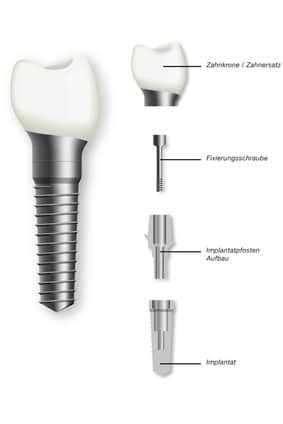dental implants / implantology
State-of-the-art titanium and ceramic implants at the best prices
OUR PRICES:
- Single tooth implant with crown without any bone augmentation technology = from 3,000 CHF
- Titanium implants & ceramic implants = 1,000 CHF surcharge per piece.
SAFE DENTURES FOR A NEW FEELING OF LIFE
Missing teeth not only lead to unsightly gaps in the teeth, but also endanger the bone stability of the jaw. Artificial tooth replacement using dental implants is now the method of choice for replacing teeth lost due to accidents, tooth decay, periodontitis or other causes. Dental implants are placed directly into the bone of the upper or lower jaw. Implants fit perfectly into the existing rows of teeth and make physically and mentally stressful gaps in your teeth disappear. Incidentally, dental implants are at least as stable as natural teeth and sometimes also serve as a supporting tooth for bridges or prostheses.
YOUR BENEFITS

Natural aesthetics

Excellent organic integration

Durable and stable

Regain quality of life

The best solution for dentures

Transparent, fair prices




WHEN DOES A DENTAL IMPLANT MAKE SENSE?
Dental implants are artificial teeth that permanently replace missing teeth. Basically, a dental implant is useful for anyone who has lost one, several or even all of their teeth. Implants are firmly inserted into the jawbone using a screw thread and fit seamlessly into the existing teeth. This gives them decisive advantages over dentures that are not fixed in the jaw or bridge constructions, which also require healthy teeth to be used for stabilization. If you have any questions about implants, we would be happy to talk to you personally. advise.
CERAMIC DENTAL IMPLANTS – THE MOST BEAUTIFUL, NATURAL CHOICE
Ceramic dental implants are currently the highest quality and most biocompatible dental implants available. It does not trigger chemical or electrical reactions in the body. Unlike titanium, which heals through an inflammatory reaction, ceramic, as a natural-like material, is accepted by the body without an immune response and grows around the bone. The ceramic implants we use from Patent™ offer excellent properties for bio-integration, which is crucial for the success of implants. Dental implants made of ceramic also fit absolutely seamlessly into the natural teeth. They look like your own teeth and are undoubtedly the most aesthetic implants.


Frequently asked questions
What are dental implants made of and how are they used?
A dental implant consists of an artificial tooth root, which looks like a screw or thread and is screwed into the jawbone by the dentist, as well as a visible artificial tooth crown (superstructure) made of metal-ceramic/all-ceramic or zirconium, which is connected to the artificial tooth root via an internal thread .
 The base of the implant as an artificial tooth root is first inserted into the patient's jaw like a screw. Normally a little local anesthesia is enough for the whole thing to be painless. This is followed by a healing and integration phase in which the implant grows firmly together with the bone. This normally lasts 2 months in the lower jaw and 2 to a maximum of 4 months in the upper jaw. The new “tooth” can then be fitted with the appropriate crown and placed under chewing load. The dental crown or superstructure is the visible part of the denture and blends seamlessly into the existing teeth, both in terms of feel, shape and color.
The base of the implant as an artificial tooth root is first inserted into the patient's jaw like a screw. Normally a little local anesthesia is enough for the whole thing to be painless. This is followed by a healing and integration phase in which the implant grows firmly together with the bone. This normally lasts 2 months in the lower jaw and 2 to a maximum of 4 months in the upper jaw. The new “tooth” can then be fitted with the appropriate crown and placed under chewing load. The dental crown or superstructure is the visible part of the denture and blends seamlessly into the existing teeth, both in terms of feel, shape and color.
For the screw, we either use tissue-compatible pure titanium or particularly high-quality ceramic screws. Both titanium and ceramic are biocompatible and are generally easily accepted by the body without causing allergic or other rejection reactions. Titanium has been used in orthopedics for decades. Zirconium ceramic implants are more recent developments. The bone then grows directly onto the surface of the screw without an intermediate layer, which is also known as osseointegration. Basically, we use implants from Champions and Patent, which have brought very high-quality materials and very innovative and patient-friendly procedures to the market.
Advantage with multiple implants: If you place several implants at the same time, especially in the toothless jaw, they can even be loaded immediately! (See below: What to do if you lose several or all of your teeth).

Here you can see the direct comparison between a dental implant system made of conventional titanium screw with attachment and the modern Patent™ system made of all-ceramic. The ceramic dental implant on the right would still look natural if the gums later receded and has proven itself as a modern method for tooth replacement.
What to do if you lose a single tooth?
If you have lost a single tooth, then implantation is the better choice as it protects neighboring teeth. A single tooth implant is placed in the place of the lost tooth root and remains unloaded under the mucous membrane during the healing phase of several weeks. During this time, you will wear temporary dentures that are fixed or removable.
With the non-surgical option, however, the lost tooth would have to be replaced with a permanent bridge, which would put unnecessary strain on the neighboring teeth and could lead to secondary damage such as secondary caries or root canal treatment. An implant avoids this bridge problem and should best be inserted 6-8 weeks after tooth loss or, if possible, directly as an immediate implant.
An immediate implant is when a tooth has to be extracted and the tooth is then directly replaced with a suitable implant. The implantation can only take place at the same time as the extraction (tooth extraction) if the tooth does not show any inflammation and the bone is sound. This prevents tissue shrinkage and saves the patient from additional surgery. Click here to watch the video .
What to do if you lose several or all teeth?
In the case of several missing teeth or an edentulous jaw, implants can be used as additional retaining elements and of course also for a firm, secure restoration. In the event of complications in full prosthetics, such as poor grip, reduced chewing performance, bone loss or the formation of wrinkles, implants enable a prosthesis to be held firmly in place and thus also prevent local bone loss. Chewing performance is massively improved and the bite height remains for longer, which also counteracts the formation of wrinkles in the corners of the mouth.
Implants mean permanent teeth and this changes both your chewing performance and your appearance. They give you back a part of your youth and are therefore invaluable!
Dental implants in conjunction with snap fasteners or other anchoring systems provide stable, secure support and lead to a new attitude to life. The number of implants required depends on the size of the bridge or prosthesis and also on whether the lower jaw or upper jaw is affected. Our philosophy here is safety combined with ease of care, both of which are essential for a long service life of the implants and oversupply.
In plain language this means the following:
- For a fixed restoration, the minimum number of implants required must be 8 in the upper jaw and 6 in the lower jaw.
- For a removable restoration (=implant-supported prosthesis) there are 6 in the upper jaw and 4 in the lower jaw.
- In our practice, we stand for uncompromising quality and durability and use the necessary number of implants to provide long-term and stable care.
Watch a computer simulation for a treatment of the lower jaw.
Innovative techniques – the approach in our practice
Implants are a very central part of dental care. They therefore do not have to be complicated or particularly expensive. That's why in my practice I use both techniques and implants that allow me to offer you simple and affordable solutions.
MIMI° techniques (minimally invasive implantation methodology).
MIMI®-Flapless – is a surgical technique that has been tried and tested for 30 years. Below is a comparison between conventional technology and MIMI®-Flapless.
The MIMI®-Flapless procedure simplifies the procedures for the dental staff and is increasingly crucial for you, the patient, as the procedure is bloodless, without cuts, formation of gum flaps and without stitches. We therefore consistently use this method whenever possible.
With the help of various sub-techniques, we are also able, in most cases, to build bones without having to undergo complex operations.
- Click here to watch the video for the conventional implantation procedure.
Building jawbone – when is it necessary?
If the jawbone has degenerated due to prolonged disuse - for example, if a tooth gap or the toothless jaw is not or only inadequately provided with dentures over a long period of time - the height or width of the bone is no longer sufficient for immediate implantation. In this case, the bone mass must first be increased again so that the implant can be supported immediately after placement and can grow optimally with it.
Height is usually a problem in the upper jaw, as the air-filled sinus enlarges into the “empty” bone after tooth loss. In this case, a so-called sinus floor elevation is usually necessary. This means that the subfloor of the paranasal sinus (=sinus) is raised (=elevation). In very advanced cases (bones less than 3 mm high) this complex method is necessary. We refer these cases to a specialist. We can solve all other cases ourselves using the so-called MIMI°-V procedure (internal sinus lift). The drill hole in the implant raises the mucous membrane of the paranasal sinus to such an extent that the implant has room at the top. New bone then fills this space or you can also use a bone replacement material. Click here to watch the video .
Width is achieved by moving the lateral bone boundaries left and right and practically creating a cavity in the middle in which new bone is formed over a certain period of time with the help of the inserted implants. This is the so-called MIMI II process.
In both cases, new bone is created, with or without bone replacement material! If necessary, we use an artificial material made of calcium or, if still available, the best dental replacement material our body has to offer: our own tooth! The material is obtained by crushing your cleaned and dried tooth in a grinder and then applying it where it is needed to stabilize the bone. This process is very cost-effective and you also know exactly where the material comes from!
Watch a little animation about the Smart grinder:
This procedure is very important if you don't want to lose any bone but can't implant it straight away: after the tooth has been extracted. You can feel the wound with the crushed tooth and the bone stays where you need it.
A final, elegant but not entirely simple method of preserving the very thin outer bone, especially in the front of the upper jaw, is to preserve part of the tooth. This is a somewhat more complex method, the meaning and use of which will be discussed with you in advance, if necessary.
Success and failure
Today, dental implants have a very good long-term prognosis: over 95-98 % of the dental implants placed by experienced dentists are still doing their job even after more than ten years. This rate speaks for itself. An implant is intended as a lifelong treatment.
In a few cases, failures can still occur, in which implants can be lost or the implant bed can become inflamed (peri-implantitis). Risk factors for implant loss include poor oral hygiene, heavy smoking, autoimmune diseases or significant bone loss in the jawbone. Overloading of the bone or a bacterial infection are also among the reasons for implant loss.
Regular check-ups at the dentist and conscientious daily oral hygiene are still the best prerequisites for long-term success of the implant treatment.
The cost of dental implants
Tooth loss and the resulting gap between teeth is not nice for anyone. Therefore, everyone should have the opportunity to compensate for this tooth loss with a stable and cost-effective dental implant. We strive to offer you affordable dental implants that are high quality but remain affordable. To achieve this, we design our way of working extremely efficiently and always focus on the latest developments.
As a guideline, you can expect to pay around 1000 per screw for a simple implantation (= without bone augmentation methods and materials). In addition, there are only the costs for x-rays and subsequent further care. This is very individual and will be agreed with you during the consultation and planning.
Zirconium implants are slightly more expensive due to the particularly high-quality material and cost around 1,600 per implant.

